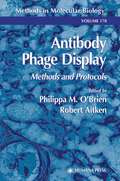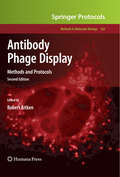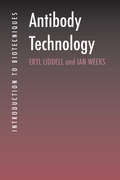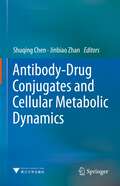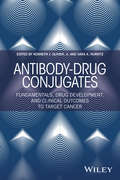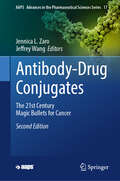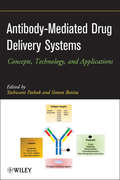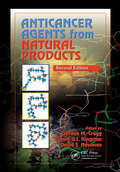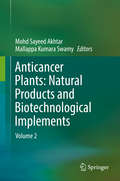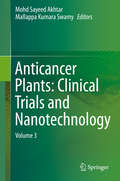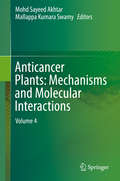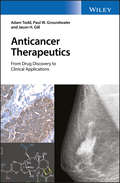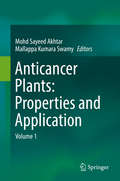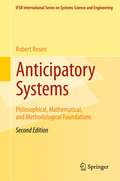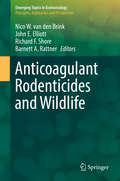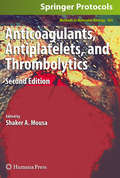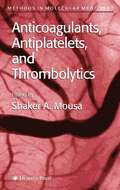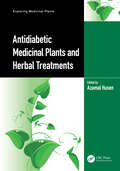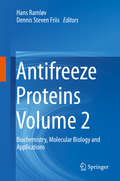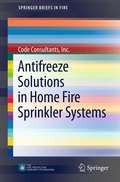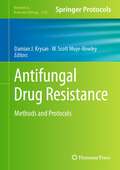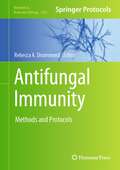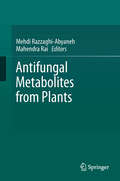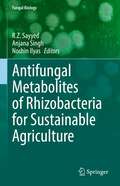- Table View
- List View
Antibody Phage Display: Methods and Protocols (Methods in Molecular Biology #178)
by Robert Aitken Philippa M. O’brienThis comprehensive collection of established antibody phage display protocols features authoritative guidance that will enable the nonspecialist successfully to carry them out. Coverage spans the construction of antibody libraries, the selection of antibody clones with the desired properties, and their modification, expression, and purification. Comprehensive and highly practical, Antibody Phage Display: Methods and Protocols provides biochemists, molecular biologists, and immunologists with a gold-standard reference guide to the successful isolation, modification, and expression of recombinant antibodies using today's powerful phage display technology.
Antibody Phage Display: Methods and Protocols (Methods in Molecular Biology #562)
by Robert AitkenSince its introduction almost 20 years ago, phage display technology has revolutionized approaches to the analysis of biomedical problems, quickly impacting the fields of immunology, cell biology, biotechnology, pharmacology, and drug discovery. In Antibody Phage Display: Methods and Protocols, Second Edition, expert researchers explore the latest in this cutting-edge technology, providing an invaluable resource that will guide readers in the design and execution of experiments based around antibody phage display. Chapters present a wide range of methods of isolating recombinant antibodies from phage display libraries, examine how the targets recognized by antibodies of interest can be identified, discuss the identification and exploitation of antibodies that can enter cells and bind to cytosolic targets, and include novel approaches to the expression of recombinant antibodies. Composed in the highly successful Methods in Molecular BiologyTM series format, each chapter contains a brief introduction, step-by-step methods, a list of necessary materials, and a Notes section which shares tips on troubleshooting and avoiding known pitfalls. Detailed and innovative, Antibody Phage Display: Methods and Protocols, Second Edition is a critical handbook on phage display technology which is certain to stimulate the reader's imagination as much as it will guide future practice in the laboratory.
Antibody Technology
by Eryl Liddell Ian WeeksThis book provides a comprehensive overview of antibody technology. It discusses in detail the new generation of engineered antibodies and the latest developments in immunoassay techniques and applications, as well as describing conventional methods of antibody production and use. Antibody Technology will bring the reader up-to-date with current methods, helping the reader to make informed decisions on the best approach to a given task with regard to cost, time and final application.
Antibody-Drug Conjugates and Cellular Metabolic Dynamics
by Shuqing Chen Jinbiao ZhanThis book summarizes the related research achievements in Antibody-drug conjugates (ADCs) and their cell metabolism kinetics. The book has three main parts. The first part describes the basic theory of ADCs, including the basic concept and structure of ADCs, and the relationship between the targets of ADCs and their specific functions. The second part mainly introduces the endocytosis and intracellular metabolism of ADCs, including the relationship between endocytosis and ADC activity, the endocytosis and intracellular transport of ADCs, the distribution and metabolism of ADC in vivo. Then it discusses the new formats and research technology of ADCs, including the application of miniaturized antibodies in ADC synthesis, novel carriers for ADC design, the technology and application of site-specific conjugation, and approaches for analyzing the drug: antibody ratio (DAR), the study of pharmacokinetics of ADCs. This book combines the basic theory with the research technology. It can be used as a reference book for students, teachers and researchers of biomedical field.
Antibody-Drug Conjugates: Fundamentals, Drug Development, and Clinical Outcomes to Target Cancer
by Kenneth J. Olivier Jr. Sara A. HurvitzProviding practical and proven solutions for antibody-drug conjugate (ADC) drug discovery success in oncology, this book helps readers improve the drug safety and therapeutic efficacy of ADCs to kill targeted tumor cells. * Discusses the basics, drug delivery strategies, pharmacology and toxicology, and regulatory approval strategies* Covers the conduct and design of oncology clinical trials and the use of ADCs for tumor imaging* Includes case studies of ADCs in oncology drug development* Features contributions from highly-regarded experts on the frontlines of ADC research and development
Antibody-Drug Conjugates: The 21st Century Magic Bullets for Cancer (AAPS Advances in the Pharmaceutical Sciences Series #17)
by Jeffrey Wang Jennica L. ZaroThe field of antibody-drug conjugates (ADCs) has undergone remarkable advancements in recent years, marked by significant progress in both drug approvals and ongoing clinical development. Since the approval of the first ADC in 2010 (gemtuzumab ozogamicin, Mylotarg®), the landscape has expanded dramatically. Today, there are 11 FDA-approved ADCs, targeting a variety of cancers across multiple indications. The approved ADCs include a range of payloads, linkers, and antibodies, each optimized for a variety of specific therapeutic targets. The increasing diversity of ADCs reflects the growing potential of these innovative treatments to address a wide array of malignancies, from hematologic cancers to solid tumors. This book aims to provide a comprehensive overview of the current state of the ADC field including the latest developments, challenges, and emerging trends, comprising expertise from a broad range of disciplines from basic research, industry, clinical practice and regulatory affairs. We explore not only the scientific and technical aspects of ADC design—such as payloads, linkers, and antibody selection—but also the developmental hurdles and regulatory complexities that influence the success of ADCs in clinical practice. Real-world examples of ADCs that have made it from the lab to the clinic offer invaluable insights into the trials and triumphs that shape this dynamic field. It is our hope that this book will serve as both a valuable resource for experts in the field and an accessible introduction for those new to the exciting world of ADCs.
Antibody-Mediated Drug Delivery Systems
by Yashwant Pathak Simon BenitaThis book covers various aspects of antibody mediated drug delivery systems - theoretical aspects, processing, viral and non-viral vectors, and fields where these systems find and /or are being evaluated for applications as therapeutics and diagnostic treatment. Chapters discuss actual applications of techniques used for formulation and characterization. Applications areas include cancer, pulmonary, ocular diseases; brain drug delivery; and vaccine delivery. The contributing authors represent over 10 different countries, covering recent developments happening around the globe.
Anticancer Agents from Natural Products
by David J. Newman Gordon M. Cragg David G.I. KingstonThe approach to drug discovery from natural sources has yielded many important new pharmaceuticals inaccessible by other routes. In many cases the isolated natural product may not be an effective drug for any of several reasons, but it nevertheless may become a drug through chemical modification or have a novel pharmacophore for future drug design.
Anticancer Plants: Volume 2
by Mohd Sayeed Akhtar Mallappa Kumara SwamyThis volume provides summarized scientific evidence of the different classes of plant-derived phytocompounds, their sources, chemical structures, anticancer properties, mechanisms of action, methods of extraction, and their applications in cancer therapy. It also discusses endophyte-derived compounds as chemopreventives to treat various cancer types. In addition, it provides detailed information on the enhanced production of therapeutically valuable anticancer metabolites using biotechnological interventions such as plant cell and tissue culture approaches, including in vitro-, hairy root- and cell-suspension culture; and metabolic engineering of biosynthetic pathways. Anticancer Plants: Natural Products and Biotechnological Implements – Volume 2” explores the natural bioactive compounds isolated from plants as well as fungal endophytes, their chemistry, and preventive effects to reduce the risk of cancer. Moreover, it highlights the genomics/proteomics approaches and biotechnological implementations. Providing solutions to deal with the challenges involved in cancer therapy, the book benefits a wide range of readers including academics, students, and industrial experts working in the area of natural products, medicinal plant chemistry, pharmacology, and biotechnology.
Anticancer Plants: Volume 3
by Mohd Sayeed Akhtar Mallappa Kumara SwamyCancer is one of the leading causes of death in human beings. Though several synthetic medicines are used to treat cancer, they are largely inefficient and unsafe. In contrast, plants, which have been used for medicinal purposes since time immemorial, have proved to be useful in fighting cancer, with natural compounds from plants and their derivatives offering safe and effective treatment and management for several types of cancer.Plants such as Catharanthus roseus, Podophyllum peltatum, Taxus brevifolia, Camptotheca acuminate, Andrographis paniculata, Crateva nurvala, Croton tonkinensis, Oplopanax horridus etc., are important source of chemotherapeutic compounds. These plants have proven their value in the treatment of cancer and various other infectious diseases, and several common anticancer compounds such as taxol, podophyllotoxins, camptothecin, vinblastine, vincristine, homoharringtonine etc. have been isolated and purified from these medicinal plants.Unfortunately, many of these anticancer plants have become endangered due to ruthless and irresponsible harvesting practices. Hence, there is a need to conserve these species and to propagate them on a large scale using plant tissue culture. Alternatively, plant cell tissue and organ culture biotechnology could be adopted to produce these anticancer compounds without the need for cultivation. A better grasp and continuing exploration of these isolated molecules and products could provide a powerful alternative means of reducing cancer risk.“Anticancer Plants: Volume 3, Clinical Trials and Nanotechnology” provides a timely review of concepts and experimental data on the application of anticancer plants and their compounds in clinical trials, and on the use of nanotechnology in cancer therapy.
Anticancer Plants: Volume 4
by Mohd Sayeed Akhtar Mallappa Kumara SwamyThis book summarizes the application of plant derived anticancer compounds as chemopreventives to treat several cancer types, focusing on the molecular mechanisms of action of phytocompounds and providing an overview of the basic processes at the cellular and molecular level that are involved in the progression of the cancer and can be employed in targeted preventive therapies. In addition, it highlights the development of novel anticancer drugs from plant sources using bioinformatics approaches. The compiled chapter data aids readers understanding of issues related to bioavailability, toxic effects and mechanisms of action of phytocompounds, and helps them identify the leads and utilize them against various cancer types effectively. Furthermore, it promotes the use of bioinformatics tools in medicinal plants to expedite their use in plant breeding programs to develop molecular markers to distinguish disease subtypes and predicting mutation, which in turn improves cancer diagnosis and prognosis, and to develop new lead compounds computationally. The book provides scientific verifications of plant compounds mechanisms of action against various cancers and offers useful information for students, teachers, and healthcare professionals involved in drug discovery, and clinical and therapeutic research.
Anticancer Therapeutics: From Drug Discovery to Clinical Applications
by Adam Todd Paul W. Groundwater Jason H. GillAn integrated presentation of the basic science and clinical applications of anticancer agents Aimed at both undergraduate and postgraduate readers, this unique text provides readers with a fully-integrated presentation of all aspects of the science of anticancer drugs, including their chemistry, pharmacology, and clinical applications. After heart disease, cancer is the number one killer worldwide, and the tumor microenvironment is forever changing, creating an ever-greater demand for safer, more effective anticancer agents. In response to that demand, the $100 billion cancer drug market continues to grow, with our increased understanding of cancer leading to new drugs being used clinically almost every year. Anticancer Therapeutics is divided into three sections. Section 1 is an introduction to cancer and therapeutics, and covers the etiology and cellular and molecular basis of cancer. In Section 2, the authors focus on the anticancer agents — their discovery, synthesis, mode of action, mechanisms of resistance, and adverse reactions. Section 3 focuses on specific cancers, explaining how and why the various agents discussed in Section 2 are used, both individually and in combination, to treat different cancers. Integrates aspects of basic science, including chemistry and pharmacology and clinical medicine in relation to cancer therapeutics Written by an author team comprising specialists in medicinal chemistry, pharmacology, and oncology Features full-color images throughout illustrating how drugs bind to cellular targets and exert their pharmacological effect Divided into three sections, covering the etiology and cellular and molecular basis of cancer, anticancer agents, and drug applications for different cancers. Providing the reader with an integrated understanding of all aspects of the science of anticancer agents, this is an ideal textbook for undergraduates studying medicine, nursing, medicinal chemistry, pharmacy, pharmacology and other allied heath / life sciences. It is also a valuable bench reference for pharmacists, medics, and pharmaceutical researchers working in both academia and industry.
Anticancer plants: Volume 1
by Mohd Sayeed Akhtar Mallappa Kumara SwamyCancer is one of the leading death cause of human population increasingly seen in recent times. Plants have been used for medicinal purposes since immemorial times. Though, several synthetic medicines are useful in treating cancer, they are inefficient and unsafe. However, plants have proved to be useful in cancer cure. Moreover, natural compounds from plants and their derivatives are safe and effective in treatment and management of several cancer types.The anticancer plants such as Catharanthus roseus, Podophyllum peltatum, Taxus brevifolia, Camptotheca acuminate, Andrographis paniculata, Crateva nurvala, Croton tonkinensis, Oplopanax horridus etc., are important source of chemotherapeutic compounds. These plants have proven their significance in the treatment of cancer and various other infectious diseases. Nowadays, several well-known anticancer compounds such as taxol, podophyllotoxins, camptothecin, vinblastine, vincristine, homoharringtonine etc. have been isolated and purified from these medicinal plants. Many of them are used effectively to combat cancer and other related diseases. The herbal medicine and their products are the most suitable and safe to be used as an alternative medicine. Based on their traditional uses and experimental evidences, the anticancer products or compounds are isolated or extracted from the medicinally important plants. Many of these anticancer plants have become endangered due to ruthless harvesting in nature. Hence, there is a need to conserve these species and to propagate them in large scale using plant tissue culture. Alternatively, plant cell tissue and organ culture biotechnology can be adopted to produce these anticancer compounds without cultivation. The proper knowledge and exploration of these isolated molecules or products could provide an alternative source to reduce cancer risk, anti-tumorigenic properties, and suppression of carcinogen activities.Anticancer plants: Volume 1, Properties and Application is a very timely effort in this direction. Discussing the various types of anticancer plants as a source of curative agent, their pharmacological and neutraceutical properties, cryo-preservations and recent trends to understand the basic cause and consequences involved in the diseases diagnosis. We acknowledge the publisher, Springer for their continuous inspiration and valuable suggestions to improvise the content of this book. We further extend our heartfelt gratitude to all our book contributors for their support, and assistance to complete this assignment. I am sure that these books will benefit the scientific communities including academics, pharmaceuticals, nutraceuticals and medical practitioners.
Anticipatory Systems: Philosophical, Mathematical, and Methodological Foundations (IFSR International Series in Systems Science and Systems Engineering #1)
by Robert RosenRobert Rosen was not only a biologist, he was also a brilliant mathematician whose extraordinary contributions to theoretical biology were tremendous. Founding, with this book, the area of Anticipatory Systems Theory is a remarkable outcome of his work in theoretical biology. This second edition of his book Anticipatory Systems, has been carefully revised and edited, and includes an Introduction by Judith Rosen. It has also been expanded with a set of Prolegomena by Dr. Mihai Nadin, who offers an historical survey of this fast growing field since the original work was published. There is also some exciting new work, in the form of an additional chapter on the Ontology of Anticipation, by Dr. John Kineman. An addendum-- with autobiographical reminiscences by Robert Rosen, himself, and a short story by Judith Rosen about her father-- adds a personal touch. This work, now available again, serves as the guiding foundations for the growing field of Anticipatory Systems and, indeed, any area of science that deals with living organisms in some way, including the study of Life and Mind. It will also be of interest to graduate students and researchers in the field of Systems Science.
Anticoagulant Rodenticides and Wildlife (Emerging Topics in Ecotoxicology #5)
by John E. Elliott Nico W. van den Brink Richard F. Shore Barnett A. RattnerCommensal rodents pose health risks and cause substantial damage to property and food supplies. Rats have also invaded islands and pose a serious threat to native wildlife, particularly raptors and seabirds. Estimates of total damage from introduced rats range into the billions of dollars in developed countries. This book aims to provide a state-of-the-art overview of the scientific advancements in the assessment of exposure, effects and risks that currently used rodenticides may pose to non-target organisms in the environment, along with practical guidance for characterization of hazards. This will be discussed in relation to their efficacy, and the societal needs for rodent control, and discussion of risk mitigation and development of alternatives. The flow in the book is planned as: a. introduction and setting the scene b. problem description (risks and effects on non-targets and secondary poisoning, development of resistance) c. ; alternatives, regulation and risk mitigation d. conclusions and recommendations
Anticoagulants, Antiplatelets, and Thrombolytics, 2nd Edition: Methods And Protocols (Methods in Molecular Biology #663)
by Shaker A. MousaDuring the past decade, remarkable progress has been made in the development of newer drugs to prevent and treat thromboembolic disorders, such as oral direct anti-Xa and anti-IIa antagonists, as well as oral antiplatelet ADP antagonists with rapid onset and offset. In addition, there has been concentrated effort aimed at identifying novel uses of traditional antithrombotic drugs, such as aspirin, heparin, and oral anticoagulants, as well as combinations of agents, such as more than one antiplatelet, antiplatelet with anticoagulant, antiplatelet with or without thrombolytic. Anticoagulants, Antiplatelets, and Thrombolytics, Second Edition provides updates on various strategies in thrombosis, experimental models, and clinical and recent advances in the discovery and development of novel antithrombotics. As a volume in the highly successful Methods in Molecular BiologyTM series, this collection provides the kind of detailed description and implementation advice that is crucial for getting optimal results. Easy to use and up to date, Anticoagulants, Antiplatelets, and Thrombolytics, Second Edition is an ideal guide for researchers aiming for the future of this vital field, focusing on the prevention of thromboembolic disorders and the protection of the vascular endothelium.
Anticoagulants, Antiplatelets, and Thrombolytics: Methods And Protocols (Methods in Molecular Medicine #93)
by Shaker A. Mousa1This collection of review articles highlights the latest development of antithrombotics and provides proven experimental methods for the further development of new and improved anticoagulants. Among the cutting-edge developments reviewed are the novel usage of low molecular weight heparins, such antithrombin agents as the hirudin, and such antiplatelet drugs as the GPIIb/IIIa inhibitors and ADP receptor antagonists. Additional innovations discussed include aspirin and clopidogrel, the expanded use of polytherapeutic approaches, antiproteases (factors IIa, Xa, and VIIa), tissue factor targeting, platelet receptor targeting, and antithrombin III modulation.
Antidiabetic Medicinal Plants and Herbal Treatments (Exploring Medicinal Plants)
by Azamal HusenDiabetes is a chronic condition associated with metabolic disorder. Persons suffering from diabetes have shown accelerated levels of blood sugar which often harms the heart, blood vessels, eyes, kidneys, and nerves. Over the past few decades, the prevalence of diabetes has been progressively increasing. Synthetic drugs are used to treat diabetic patients to help control the disorder, but it is shown that numerous medicinal plants and herbal drugs are widely used in several traditional systems of medicine to prevent and treat diabetes. They are reported to produce beneficial effects in combating diabetes and alleviating diabetes-related complications. These plants contain phtyonutrients and phytoconstituents demonstrating protective or disease preventive properties. In many developing countries, herbal drugs are recommended by traditional practitioners for diabetes treatment because the use of synthetic drugs is not affordable.Key Features: Provides botanical descriptions, distribution, and pharmacological investigations of notable medicinal and herbal plants used to prevent or treat diabetes Discusses phytochemical and polyherbal formulations for the management of diabetes and other related complications Contains reports on antidiabetic plants and their potential uses in drug discovery based on their bioactive molecules This volume in the Exploring Medicinal Plants series provides an overview of natural healing treatments in selected antidiabetic plants. The book presents valuable information to scientists, researchers, and students working with medicinal plants or for those specializing in areas of ethnobotany, natural products, pharmacognosy, and other areas of allied healthcare. It is also useful to pharmaceutical companies, industrialists, and health policy makers.
Antifreeze Proteins Volume 1: Environment, Systematics and Evolution
by Hans Ramløv Dennis Steven FriisThis first volume provides a comprehensive overview on evolutionary, environmental and systematic aspects of antifreeze proteins. It shortly explains the physical properties of ice and further intelligibly describes the biology of the antifreeze proteins in different organisms, and offers a detailed insight into their history of evolution. In addition the book discusses the status of the current knowledge and ongoing research and highlights also those parts, where further investigation needs to be done. Together with the second volume on the biochemistry and molecular biology of antifreeze proteins, this book represents a unique, comprehensive work and a must-have for students and scientists in biochemistry, evolution, physiology and physical chemistry.
Antifreeze Proteins Volume 2: Biochemistry, Molecular Biology and Applications
by Hans Ramløv Dennis Steven FriisThis second volume, written in four parts, offers the reader a thorough review on molecular, structural and applied aspects of antifreeze proteins. The first part treats the structure-function relationship and the physicochemical properties of antifreeze proteins; the second part provides insight into molecular mechanisms affected by antifreeze proteins; the third part presents some of the potential applications in various professional sectors and in the last part the book content is summarized and future research directions and ideas are discussed. Together with the first volume on the environment, systematic and evolution of antifreeze proteins, this book represents a unique, comprehensive work and a must-have for students and scientists in biochemistry, molecular biology, biotechnology and physical chemistry.
Antifreeze Solutions in Home Fire Sprinkler Systems: Antifreeze Solutions In Home Fire Sprinkler Systems (SpringerBriefs in Fire)
by Inc. Code ConsultantsAntifreeze Solutions in Home Fire Sprinkler Systems examines the usage of antifreeze solutions in residential sprinklers, and analyzes their effectiveness in controlling a fire condition and aiding in containment. The book also investigates the possibility of a large-scale ignition occurring from solutions of varying mixtures, and proposes the optimal ones for reducing flammability. Antifreeze Solutions in Home Fire Sprinkler Systems is designed for practitioners as a reference guide for handling antifreeze solutions in residential sprinkler systems. Researchers working in a related field will also find the book valuable.
Antifungal Drug Resistance: Methods and Protocols (Methods in Molecular Biology #2658)
by Damian J. Krysan W. Scott Moye-RowleyThis detailed volume aims to elucidate the molecular mechanisms that underlie antifungal resistance. The book highlights methods to identify and characterize antifungal activity, to define and characterize strains with altered responses to antifungal drugs, to investigate the genetic and molecular mechanisms of these alterations of antifungal drug susceptibility, and, finally, to approach the study of these processes in animal models of fungal infection. Written for the highly successful Methods in Molecular Biology series, chapters include introductions to their respective topics, lists of the necessary materials and reagents, step-by-step and readily reproducible laboratory protocols, as well as tips on troubleshooting and avoiding known pitfalls. Authoritative and practical, Antifungal Drug Resistance: Methods and Protocols serves as an ideal resource for the field and a guide for investigators to study this important translational aspect of fungal biology.
Antifungal Immunity: Methods and Protocols (Methods in Molecular Biology #2667)
by Rebecca A. DrummondThis volume aims to help new investigators to the field by providing them with the protocols needed to set up clinically relevant animal models of fungal infection, as well as methods for in vivo immunology.Written in the format of the highly successful Methods in Molecular Biology series, each chapter includes an introduction to the topic, lists necessary materials and methods, includes tips on troubleshooting and known pitfalls, and step-by-step, readily reproducible protocols. Authoritative and cutting-edge, Antifungal Immunity: Methods and Protocols aims to be comprehensive guide for researchers in the field
Antifungal Metabolites from Plants
by Mahendra Rai Mehdi Razzaghi-AbyanehThe goal of this book is to provide essential information on the use of different medicinal plants and their secondary metabolites for the treatment of various fungal diseases affecting human beings, animals and plants. It is divided in four parts: Part I examines the global distribution of plant-derived antifungal compounds, Part II deals with antifungal activities of plant metabolites, Part III includes plants used in Ayurveda and traditional systems for treating fungal diseases, and Part IV discusses the use of plant-derived products to protect plants against fungal diseases.
Antifungal Metabolites of Rhizobacteria for Sustainable Agriculture (Fungal Biology)
by R. Z. Sayyed Anjana Singh Noshin IlyasAntifungal Metabolites of Rhizobacteria for Sustainable Agriculture focuses on plant health in agro-ecosystems of various economically important cash and food crops with a concern to promote sustainable agriculture. They have emerged as a key organic tool for enhancing yields. In a natural environment the interactions between plants and phytopathogenic fungi are complex and survival requires a development of resistance to plant diseases. Diversity of Plant Growth Promoting Rhizobacteria (PGPR) diversity depends on the nature of root exudates and soil conditions that affect their interaction with host plants. Novel strategies, such as, applying bioactive natural products against the pathogenic fungus are required to control disease sustainably. Various classes of secondary metabolites including lipopeptides, macrolides, alkaloids, terpenoids and phenolics from microorganisms and plants strongly suppress fungal growth and can also be effective in controlling plant diseases both in vitro and in vivo. The modes of actions of some potential antifungal secondary metabolites against pathogenic fungus are also discussed.Eco-friendly fungal species and their metabolites are excellent agents used for regulating various fungal and bacterial phytopathogens and may have tremendous potential for other applications, and play a key role in enhancing plant tolerance to stress. Antifungal Metabolites of Rhizobacteria for Sustainable Agriculture also covers bovine-based formulations used for sustainable production and nutritional security through horticultural crops, thereby addressing the problems associated with malnutrition and under-nutrition encountered by small and marginal farmers, as well as by families facing resource constraints. These techniques can also improve breathable air, drinkable water, and consumable foods. This book addresses the need to mitigate the health problems of people via organic crop production and to improve the socio-economic status of farmers (especially in developing countries), and to revitalize agricultural sustainability.
